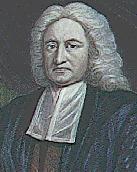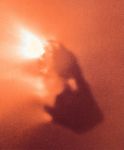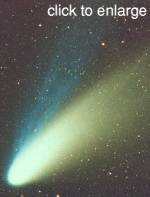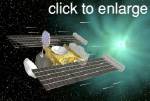
 |
Comets - visitors from afar |
|
| |
|
Comets are frequently described as muddy snowballs, although they are not made of frozen ice water. Instead, they consist of rock, dust and frozen methane, and some other frozen gases. Their orbits are much more elliptical than planets, coming from far beyond the orbit of Pluto. As they get closer to the Sun, the ice begins to melt. A gigantic tail forms, since the comet's gravity is too weak to hold onto the gases produced as an atmosphere. Twice in a Lifetime? The first astronomer to successfully study comets in detail was Edmund Halley (right) (1656-1742), of The Queen's College, Oxford. Close friend of the then recluse Isaac Newton, Halley took Newton's laws of cometary motion one stage further - by proving that the comet they had seen in 1682 had been seen many times before. He boldly predicted that it would return in 1758. Unfortunately Halley died - but the comet returned, sighted the night of Christmas Day 1758 by Farmer Palitzsch. The first astronomer to successfully study comets in detail was Edmund Halley (right) (1656-1742), of The Queen's College, Oxford. Close friend of the then recluse Isaac Newton, Halley took Newton's laws of cometary motion one stage further - by proving that the comet they had seen in 1682 had been seen many times before. He boldly predicted that it would return in 1758. Unfortunately Halley died - but the comet returned, sighted the night of Christmas Day 1758 by Farmer Palitzsch.
Halley's Comet First studied in detail in 1985/6. An armada of spacecraft were sent that included two Japanese probes, Sakigake and Suisei, two Russian probes, Vega 1 and 2, and a European spacecraft, Giotto, the only one passing close enough to view the nucleus (shown right). Giotto was built in Bristol, by British Aerospace. First studied in detail in 1985/6. An armada of spacecraft were sent that included two Japanese probes, Sakigake and Suisei, two Russian probes, Vega 1 and 2, and a European spacecraft, Giotto, the only one passing close enough to view the nucleus (shown right). Giotto was built in Bristol, by British Aerospace.
Soviet CollaborationThe last Soviet exploration of Venus took place in 1985 with the Vega 1 and 2 missions. The spacecraft had dual missions to explore both Venus and Comet Halley. The Soviets received considerable help with hardware development and mission operations from Western European nations. They reached an agreement with ESA to use America's Deep Space Network for tracking the Vega probes when they reached Halley.The Great Hale Bopp Comet Hale-Bopp was discovered in July 1995, when it was more than seven hundred million miles from Earth (over 7× the Earth-Sun distance). Remarkably, it was discovered by an amateur using a telescope with a mirror only 17·5 inches in diameter. Thomas Bopp was relatively new to amateur astronomy. Looking at the globular cluster M70, Bopp asked what the fuzzy blob next to the cluster might be. It proved to be a new comet. Comet Hale-Bopp was discovered in July 1995, when it was more than seven hundred million miles from Earth (over 7× the Earth-Sun distance). Remarkably, it was discovered by an amateur using a telescope with a mirror only 17·5 inches in diameter. Thomas Bopp was relatively new to amateur astronomy. Looking at the globular cluster M70, Bopp asked what the fuzzy blob next to the cluster might be. It proved to be a new comet.
Shooting StarsComets and shooting stars are often mistaken for each other. In reality, comets remain effectively stationary in the sky, if visible at all, whereas so-called shooting stars flash rapidly over the sky. Find out the connection between the two.Where Are They From?Short-period comets, such as Halley, are thought to come from a belt of material called the Kuiper Belt, beyond the orbit of Pluto. Longer-period comets are thought to originate in the more distant Oort Cloud. |
Twice in One Night!That same night the comet was detected independently by Alan Hale, a professional astronomer working in New Mexico. That Hale-Bopp was discovered whilst it was far from the sun implies that it is intrinsically bright and fairly large. Luckily Hale-Bopp passed behind the Moon (called an occultation). This allowed astronomers to gauge the diameter of the comet's nucleus by measuring how long it took to disappear behind the edge of the Moon. Calculations indicate that the nucleus of Hale-Bopp may be more than 40 km in diameter. The nucleus of Comet Hyakutake, by comparison, is less than 3 km in diameter; Comet Halley's nucleus measures about 15 by 8 km. Comet Flyby! In September 2001, NASA's Deep Space 1 flew past comet Borrelly. It took the most detailed images yet of a comet's nucleus - and wasn't even designed to do this job! Instead, it was at the end of its mission to test new space technologies. In September 2001, NASA's Deep Space 1 flew past comet Borrelly. It took the most detailed images yet of a comet's nucleus - and wasn't even designed to do this job! Instead, it was at the end of its mission to test new space technologies.
Ultimate Fate: JupiterAs Earthlings, we should be thankful of the existence of Jupiter, by far the lagest planet in the Solar System. Containing more mass than all the other planets rolled together, it acts as a cosmic vacuum cleaner, making stray comets crash into it rather than the Earth, for example. In 1995, this is indeed what happened to Shoemaker-Levy. More detail. The Sun is also frequently hit by comets, for obvious reasons. Solar impacts.To a Comet and Back Again... NASA's Stardust probe (right), launched in 1999, encountered comet Wild 2 (prn. "vild") in January 2004. It became the first spacecraft ever to bring material - thousands of tiny dust particles - from comets (as well as dust from space) to Earth for analysis. After travelling 3 billion miles and passing within 149 miles of the comet nucleus, it returned a 45 kg capsule to Earth on 15th January 2006 at 1012 GMT. It had reached speeds of 29,000 mph - the fastest ever re-entry. The mother ship zoomed past the Earth and is now in permanent orbit around the Sun. NASA's Stardust probe (right), launched in 1999, encountered comet Wild 2 (prn. "vild") in January 2004. It became the first spacecraft ever to bring material - thousands of tiny dust particles - from comets (as well as dust from space) to Earth for analysis. After travelling 3 billion miles and passing within 149 miles of the comet nucleus, it returned a 45 kg capsule to Earth on 15th January 2006 at 1012 GMT. It had reached speeds of 29,000 mph - the fastest ever re-entry. The mother ship zoomed past the Earth and is now in permanent orbit around the Sun.
Rosetta Launched on 26 February 2004, ESA's Rosetta will rendezvous with Comet Churyumov-Gerasimenko in November 2014. It will be the first ever spacecraft to perform a soft landing on a comet's nucleus, allowing the most in-depth study ever! Launched on 26 February 2004, ESA's Rosetta will rendezvous with Comet Churyumov-Gerasimenko in November 2014. It will be the first ever spacecraft to perform a soft landing on a comet's nucleus, allowing the most in-depth study ever!
Rosetta itself will remain in orbit. A lander, called Philae, will descend to its surface (from 1 km up, at only 1 metre per second!) once the nucleus has been mapped to locate a suitable landing site. Due to the comet's very weak gravity, Philae will anchor itself with harpoons. The two probes will study what the comet is made of, materials believed to have remained unchanged since the solar system formed nearly 5 billion years ago. GCSE MaterialFind out much more about comets on GCSE.com. View/Sign Guestbook
|
|
Sun | Mercury | Venus | Earth | Moon | Mars | Asteroids | Jupiter | Saturn | Uranus | Neptune | Pluto | X | Kuiper | |